Cooperating at a shared workplace
Kuvateksti: There is a lot of traffic at the ground level of the airport. Passengers, freight and fuel are transported, and several enterprises take part in preparing planes for take-off.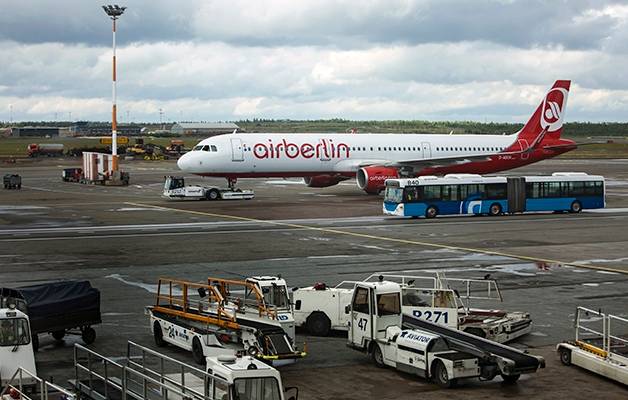
When employees of different employers work at a shared workplace, occupational safety can be very challenging. At the Helsinki-Vantaa Airport collaboration to ensure safety has been refined to perfection.
Work contracts are more and more fragmented in the turmoil of work life. Earlier, there were only the employees of one enterprise at one workplace, but today, the employees of many subcontractors may be working on the same premises – permanent employees as well as temporary and hired workers.
Also physical workplaces are being fragmented. Old factory complexes are converted into industrial parks where numerous small businesses operate. The infrastructure may be the only thing they have in common. Also in shopping centres the premises are shared by all, and the spaces are partitioned by only glass or thin walls.
We speak of shared workplaces when the personnel of many different employers work simultaneously or consecutively in the same workplace or on the same premises. The more complex that the work contracts of the workers become, the more challenging becomes the management of occupational safety and health.
Communication is vital
Industrial enterprises have typically delegated work to subcontractors. The outsiders are often given relatively risky jobs, such as cleaning, maintenance, building and assembling projects, as well as transporting materials.
Researcher Sanna Nenonen from Tampere Technical University has studied the risk factors that prevail in a shared workplace. In her doctoral dissertation four years ago, she found that at least different work cultures, unclear responsibilities, and deficient communication appear to cause problems.
– For instance, ensuring a sufficient flow of information, recognizing hazards, proper planning of work, as well as providing work guidance, are a challenge at a shared work site, explains Nenonen in her doctoral thesis.
The problems reported by the service providers were the same ones that caused serious occupational accidents.
– Because different actors operate at shared workplaces, the safety of everyone at the work site is affected. And guaranteeing safety is the responsibility of both those who have ordered the work, as well as of the service providers and their workers at the site, says Nenonen.
– The duty of the main contractor at a work site is to take care of the safety of the overall work arrangements at the site. He must also make sure that communication and cooperation are properly organized, explains Professor Jouni Kivistö-Rahnasto from Tampere Technical University.
How has safety at shared workplaces developed in recent years?
– I don’t have any statistics, but I believe that people have learned to interact better. Those who generally take better care of things are the ones who have invested in safety, answers Kivistö-Rahnasto.
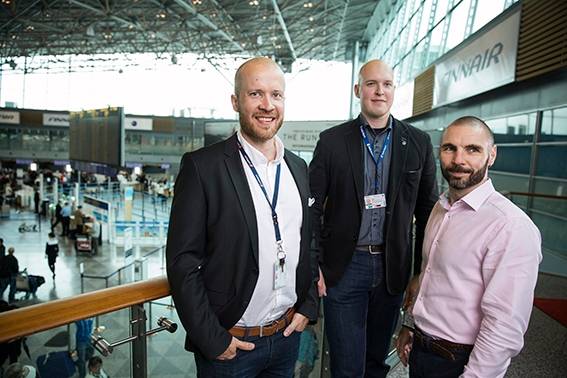
Ville Mäkinen from Swissport, Markku Tanni from Finavia and Niko Reunanen from WDFG are ‘colleagues’ when it comes to the safety of the airport.
Scheduling helps
The Helsinki-Vantaa Airport is a good example of a huge area that contains shared workplaces. This ‘small city’ spreads over 19 square kilometres and houses about 1300 enterprises. The employment contracts of altogether about 15,000–20,000 people at the airport are diversely different.
One of the enterprises operating shared workplaces is the international WDFG (World Duty Free Group) which owns Duty Free shops at the airport. About 180 persons are employed in its eleven shops. An additional 90 people are hired workers and product presenters of different brands.
The main risk at work is connected to the handling of the products on sale: the moving of crates and the lifting of heavy boxes.
– Also working while standing has a negative effect on health. The sales personnel stand for long hours on hard floors, says Niko Reunanen, occupational safety chief of WDFG.
WDFG has made the work safer by careful planning of timetables, among other things.
– We now know what kind of equipment and at what times the products should be brought in from the storage to the shops, so that nobody will get caught underfoot in the transfers.
The work processes as well as safe work procedures are explained in detail as part of the work guidance to each person working at WDFG, regardless of which enterprise pays their salary.
– All noticed safety hazards must be brought to the attention of the first supervisor who comes along, even if he or she is not the closest supervisor. We emphasize that everybody’s observations are important, and they should be reported immediately.
”To complicate matters, the situation of a hired worker and a subcontractor’s worker is different at shared workplaces.”
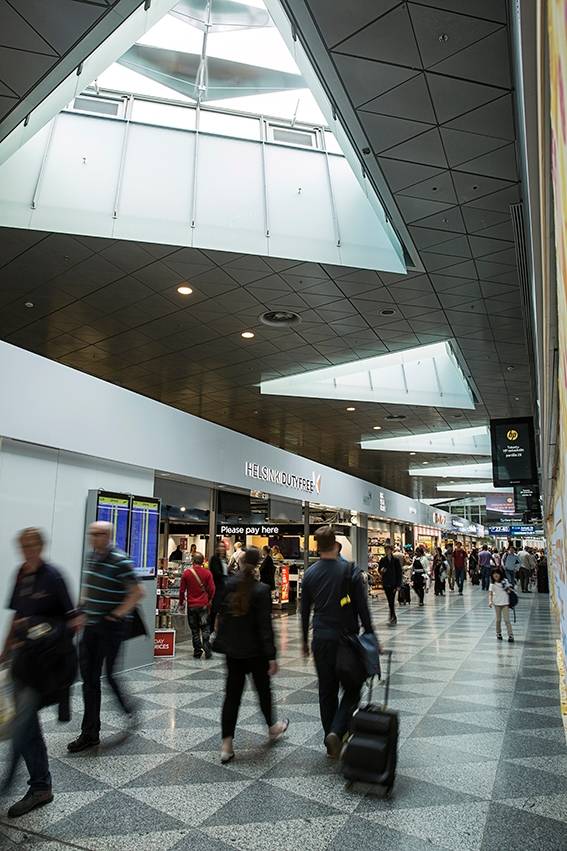
The prevention of risks as well as passenger safety and occupational safety go hand in hand in the terminal building.
The different situation of hired workers
– To complicate matters, the situation of a hired worker and a subcontractor’s worker is different at shared workplaces, professor Kivistö-Rahnasto mentions.
The employees of a subcontracting firm work under the firm’s own supervisor. A hired worker, on the other hand, works under the supervision of the firm ordering the hired help, and that firm is also responsible for his or her safety at work.
– The occupational health care of hired workers is arranged by their own employer. From this it follows that the occupational health specialist of such an employer does not visit all the different work sites, and may not even be aware of their particular hazards, says Kivistö-Rahnasto.
WDFG has solved this complex dilemma, and assumes equal responsibility for everybody’s safety and health.
– For instance, even though the product presenters of different brands have their own supervisors elsewhere, once a month they attend a meeting where safety matters are discussed. Also the occupational health of hired workers is taken into account, says Niko Reunanen. He thinks it would be a good idea to share the results of the workplace surveys and risk assessments with the occupational health personnel of the hired workers.
Mila Hälinen, product presenter, is employed by the beauty brand La Mer. She is now working, and the second rush hour at the airport terminal is just starting. An almost unending stream of Chinese passengers is beginning to flow through the doorway.
– The occupational health nurse from WDFG was just here to check my working ergonomics, says Hälinen, and points at a new standing support installed near the cash register, and a flexible ‘ergomat’ to soften standing. There is also a chair next to the work site for sitting down and resting the feet.
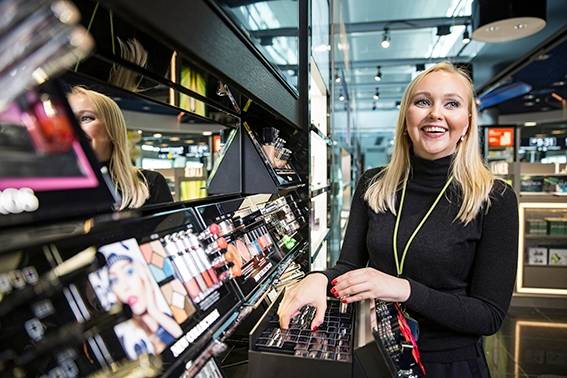
Product demonstrator Mila Hälinen is confident that the health of also temporary employees is taken care of at her workplace.
Cooperation needs to be improved
An airport shop differs entirely from industrial plants, where the collaborative work of different actors has been studied a great deal. Research nevertheless shows how safety could be improved in cooperation in also other workplaces involving several actors.
According to § 49 of the Occupational Safety Act, the employer exercising the highest managerial control has to make sure that external employers and their employees have been informed and instructed sufficiently about the hazards and risks, as well as the regulations regarding the safety of the work and the workplace. Professor Kivistö-Rahnasto feels that there is room for improvement in carrying out the law.
– Subcontractors who provide services to industries have expressed the wish that safety should be given more attention in the joint meetings with the people who have ordered the services.
Kivistö-Rahnasto says that people should get together to assess hazards at several phases of the process: first in the tendering and agreement stage, when the work site is taken into control, when the work site is first inspected, and when work tasks are planned.
In addition to the basic work guidance, the main contractor should provide work instructions for carrying out the work safely.
– The agent ordering the work may think that skilled workers don’t need to be instructed in safe work practices. However, the subcontractor’s employees have to adjust to different working conditions and new workmates at each work site.
There is no ‘boss’ in a partnership
The top management is sometimes missing in shared workplaces. Shopping centres, industrial parks, shipyards and airports are typical places where enterprises have a rental contract, or are in an equal partnership with the agent ordering the work.
An example of a partnership is found at the airport, outside the terminal building. There is continuous traffic on the ground level, between the building and the runways. The workers operate vehicles that carry freight, luggage, fuel and passengers, and they also maintain the planes.
Swissport is one of the enterprises operating on the ground level at the airport. It employs 850 people at the Helsinki-Vantaa airport: in customer service as well as the handling of luggage and air freight.
Forwarding the plane, or ‘turning’ it, is a chain of work tasks. When one firm completes its task, the next one takes over. And everyone is busy: the plane must be ready to leave quickly; on the ground it is not profitable.
On the ground level each enterprise is responsible for its own employees. There is a high level of risk when the vehicles and workers of different enterprises get on the same collision course.
– One of the risks is getting run over by a moving vehicle. I remember a few cases from my work history, says Ville Mäkinen, safety chief at Swissport.
Communication between the different employers is absolutely necessary to ensure traffic safety in the area.
– All enterprises should know what the other firms are and what they do, Mäkinen points out.
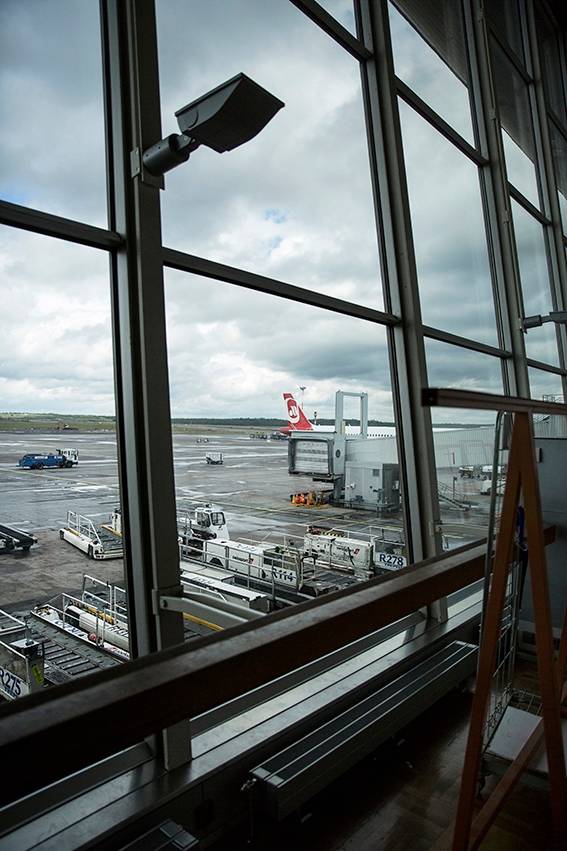
Managing timetables is of utmost importance when the workers of several different enterprises work simultaneously to prepare a plane for take-off.
Airlines determine their own regulations
Each airline company, for example Finnair, orders the services needed for the ground forwarding of their plane from their partner enterprises.
– Swissport is a service provider for the airlines, not their subcontractor. So individual airlines do not coordinate overall occupational safety. On the ground, all of us operate in accordance to the processes of the client airline.
The regulations of the client airlines determine the order and timetable of carrying out specific services, and also who the service providers are. When orders are followed carefully, working is safe, says Mäkinen.
Markku Tolvanen, specialist at the Centre for Occupational Safety (TTK), knows that chain work and its problems grow when enterprises and their operations are broken into smaller entities for smaller firms.
– Although people work in the same area, everyone tends to act as an individual and concentrates on their own job. The bigger picture is overlooked.
Mastering schedules is of utmost importance in managing chain work. According to Tolvanen, special attention should be paid to preliminary planning.
– When the timetable is too tight in some part of the work chain, it impacts everything and causes haste and stress, and even dangerous situations. For instance in construction, if the timetable doesn’t allow enough time for the concrete to dry properly, the poor results must later be fixed in an even greater hurry.
According to Ville Mäkinen from Swissport, information exchange between enterprises that do chain work is a major factor leading to a successful end result.
– When real-time data is available about problems, it gives time for the next people in the chain to react.
Mäkinen explains that delays and other operational information needed in turning the plane, that is, preparing it for take-off, are reported immediately to the company coordinating the operation, which then passes on the information to the other parties involved.
– We do try to be prepared for unexpected situations beforehand. Reports about problems and hazardous situations are important for planning safety. These reports provide information for the future: what kind of things can happen and how could similar problems be prevented.
”At the time when the Occupational Safety Act was enacted, the responsibility for organizing occupational safety in shared workplaces was not yet determined.”
The law requires cooperation
The Occupational Safety Act states that occupational safety must be ensured, even when no employer is responsible for the overall supervision of the shared workplace. The law stipulates neighbouring enterprises to inform also other employers about risks and their prevention.
Cooperation can also focus on, for instance, preventing the threat of violence or planning safe traffic arrangements. In such situations, however, the law does not determine whose responsibility it is to get people together from different enterprises to plan safe procedures.
Markku Tolvanen from the Centre for Occupational Safety emphasizes that safety management is the key to safety at shared workplaces. The safety representatives of the different employers should make plans together.
– It would be a good idea if these safety representatives would look at all the activities from the viewpoint of the entire area, such as a shopping centre or an airport.
Tolvanen has experience especially in shared workplaces in industrial parks where, for instance, the empty space of a closed-down factory is rented to different enterprises. The common element is the owner who owns and rents out the premises.
The workplaces in industrial parks entail many hazards. One enterprise may use flammable gas, and the neighbouring one may use fire. Because of the common dangers, infrastructure and liabilities, the firms operating in an industrial park have drawn up cooperation agreements signed by all parties.
– In some industrial parks the enterprises have set up a team which observes all the on-going activities and gives feedback, spreads know-how, and even provides training in overall safety, Tolvanen says.
He believes that also in other corresponding workplaces, such as shopping centres, the owner who rents out the spaces might be the most natural person to organize safety management. But this is a complicated matter because the law does not require it.
– At the time when the Occupational Safety Act was enacted, the responsibility for organizing occupational safety in shared workplaces was not yet determined. In this respect the law should be clarified in more detail.
Voluntary coordination of cooperative action
At the Helsinki-Vantaa airport, the uniting factor is Finavia which is responsible for the operations of the airport and also rents out space for enterprises. Finavia has about 300 of its own employees, and hires additional help during rush hours. Furthermore, it has outsourced the maintenance of the building as well as security check services, duties designated by the aviation legislation.
– Finavia is responsible for the occupational safety of its own employees. Because we rent out space, we are obliged to follow the official regulations related to the maintenance and safety of the premises. Furthermore, we are obligated by the regulations of Trafi (Finnish Transport Safety Agency) and of the aviation legislation, which define the safety requirements for the users of airports, says Markku Tanni, occupational safety chief at Finavia.
Finavia has voluntarily started to coordinate cooperation among the employers at the airport.
– We have numerous safety forums. Thirty of the biggest employers are members of the occupational safety cooperation forum. When the forum was founded, it included about 90% of the employees on the premises.
Tanni mentions another example of cooperation – the occupational safety development group, which provides an opportunity for discussing typical questions related to safety. Other communication channels related to safety, when needed, are for example the Apron Safety Team operating at the airport.
– Fortunately we don’t have to wait for committees to be set up to get things done, says Niko Reunanen from WDFG, and continues:
– Safety is a natural part of everyday work life. If, for instance, our employees see even a minor potential hazard in a public area, such as a slippery floor or a broken lamp, they report it right away to their own supervisor. The supervisor then informs Finavia.
– A serious problem in public areas might be a careless, indifferent culture where defects are not mentioned to anyone. We are fortunate to have a well-functioning system here, says Tanni.
Many shared workplaces
According to Markku Tanni, the airport is clearly a more complex shared workplace than for example a construction site, a dockyard or a factory hall.
– The whole airport consists of a great number of shared workplaces. Their activities are spread over large areas and are connected to each other.
For instance, the ground forwarding process of Swissport begins inside the terminal building at the check-in desk, continues along Finavia’s luggage conveyor, and then outside the building to the forwarding system.
– That is why the limits of liability cannot be drawn on a map. The functions always dictate how we approach the liability question: what is being done, who are the actors involved, and who has the actual power to control the whole picture. Then together we decide who does what, Tanni explains.
At Finavia, the safety issues of the airport are therefore agreed upon right from the beginning of the cooperation.
– We go over a list of safety issues in the contract with the subcontractor or lessee. The list includes for instance questions on flight safety and occupational safety, as well as recognizing and preventing possible illegal acts in advance. The contracts also include compliance with the decisions of the cooperation forum, says Tanni.
The safety of a shared workplace also means that the workers know who belongs to the workplace and who doesn’t. At big construction sites this has been solved by requiring workers to carry an ID pass. At the airport a special permit procedure is used: Trafi and the EU Commission require a background check of persons working on the premises. After the check-up, Finavia grants the permits.
The airport is a safe place to work also because the authorities are always present: the police, customs, and border guard. In addition, the rescue service of the Helsinki-Vantaa Airport is in readiness around the clock.
– Of course we do have a rescue plan as stipulated in the rescue law. We also organize training on rescue skills for enterprises and their employees. Our readiness to tackle threats related to explosives and terrorism is based on plans drawn up together with the authorities.
Sources and literature:
Nenonen, Sanna: Implementation of Safety Management in Outsourced Services in the Manufacturing Industry. Tampere University of Technology, 2012.
Pelastuslaki (Rescue Act) 29.4.2011/379
Turvallisuus teollisuuspuistossa, opas (Safety in industrial parks, guide) 2008. VTT (Technical Research Centre of Finland), Helsingin yliopisto (University of Helsinki).


Kommentoi